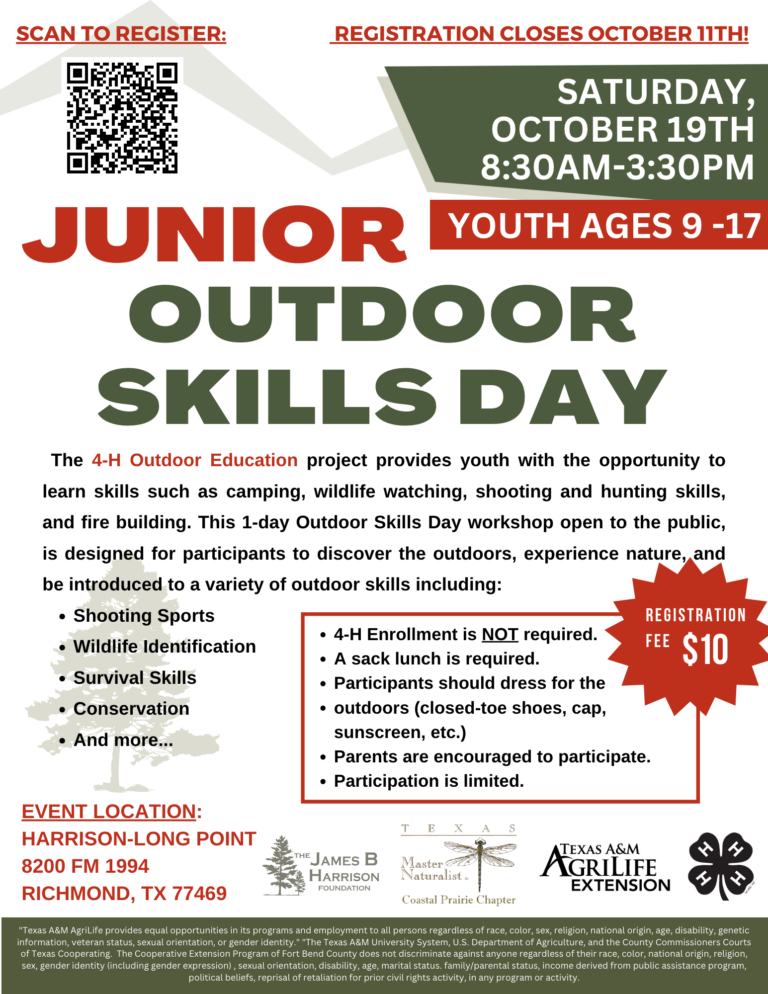Contests & Activities
Wildlife Challenge
The Wildlife Challenge covers material found within five 4-H Natural Resources projects; Wildlife Habitat Education Program (WHEP), the Hunting & Wildlife Discipline in Shooting Sports, Entomology, Forestry, and Sportfishing. Contestants will have the opportunity to explore all five of these projects while preparing for the Challenge. Contestant check-in will begin at 8:00 a.m. in the designated contest location. Awards will be presented on site following score tabulations. Contestants will compete as a county team of 3 or 4 or as individuals. Contestants will compete within intermediate and senior age divisions. The contest consists of three activities as described below. Each activity may be completed individually or as a team as designated on contest day. Each activity may cover any or all of the specified information within the five 4-H Natural Resources project areas’ resources listed below. Contestants will need a clipboard and several sharpened pencils to use during the contest. Some parts of the activities may be conducted outdoors. Contestants should be appropriately dressed for the weather and field conditions (tall grass, brush, off the sidewalk, etc.)
Contest Activities –
Identification: Contestants will identify animals and trees from pictures or actual specimens such as leaves, fruit/nuts, skulls, skins, wings, specimen mounts, tracks, calls, etc. Contestants will identify wildlife habitat concepts, wildlife habitat components, and wildlife management practices from photos or in the field. Contestants will identify equipment and equipment components that may be found within any of the project resources (i.e. – fishing equipment, shooting equipment, insect collecting equipment, etc.)
Decision Making: Contestants will choose or demonstrate the best answers to solve the issues within scenarios presented to them based on information pertaining to the five project areas’ resources. Knowledge and Skills Assessment: Contestants will answer multiple-choice questions and perform skills found within the five project areas’ resources. This could include but is not limited to fishing skills, insect collection and display, firearm handling, and other skills found within the resources.
Range & Pasture Grass Identification
This judging contest is usually held indoors. The contestant is provided a 50 grass contest score card on which written grass name answers and characteristics are marked. Contestants identify 50 live or mounted grass specimens from Extension publication RS1.044, Master Plant List (2011). Spelling the name of a grass correctly is important. Contestants will classify each grass specimen according to their life span, season of growth, origin, and grazing value for livestock and wildlife. Each contestant is required to bring 1) a legal size clipboard, 2) multiple pencils and 3) a magnifying glass with or without a light if used by the contestant. An outdoor practice area for study is available on the day before the contest by contacting the Contest Superintendent.
Range Evaluation
The 4-H Range Evaluation Contest is held outdoors in a suitable rangeland situation. The contest has three parts: Part 1 – Plant Identification, Part II – Range Evaluation and Part III – Rangeland Health. For Part I, contestants identify 20- 40 staked plants (grasses, forbs, legumes and woody plants). Plants used in the contest come from the 4-H Master Plant List RS1.044 (2011). Part II consists of a ranch, a pasture or part of a pasture providing a management situation. Part II is divided into seven sections where contestants evaluate the degree of utilization, kind of site, successional stage, similarity index, vegetative state, recommended stocking rate, and management decisions. Part III has 4 small-staked plots for use in evaluating range health. Contestants evaluate each plot separately, checking the range health problem indicator(s) that they observed in each plot. Secondly, contestants check a box for each plot’s range health category (healthy, at risk, or unhealthy) depending on the number of health problems observed in that plot. Contestants will use the same 4 small-staked plots for the “Plot Evaluation” section. The contestant must determine which of the plots (1, 2, 3, or 4) contains the item asked for in each of 10 categories. An outdoor practice area for study is available on the day before the contest by contacting the Contest Superintendent. A list of plants, a Range Evaluation Contest Manual and score cards are available on the State 4-H web site or by contacting the Contest Superintendent. Contestants are required to bring a clipboard, multiple pencils, and one 2 gallon zip-lock bag for use if inclement weather occurs. Score cards for Part I, Part II, Part III and a Part II worksheet are provided to contestants on the day of the contest.
For More Information:
http://texas4-h.tamu.edu/project_range/
Soil Judging
Judge four soil profiles with 20-minutes allowed for each. Determine the soil characteristics of the profiles and make interpretations based on observation. Coaches are responsible for all transportation to and from contest site. Coaches are also required to assist in operation of the contest through grading of score cards and serving as pit monitors.
Each contestant is required to provide the following items for their use during the contest:
- water bottle for textural analysis
- tape measure
- clipboard
- multiple pencils
- appropriate knife or similar digging tool
Outdoor Challenge
As never before, today’s youth face an ever-increasing disassociation with natural areas and its resources. This is as a result of many factors including urbanization, educational priorities, family structure, culture, priorities, values, and beliefs. This trend is detrimental not only to the individual’s knowledge and awareness of the resource, but also (and likely more important) a detriment to the resource itself. This disassociation with natural areas can lead to lost learning opportunities, potential lack of involvement, and/or loss of natural resources. The Texas 4-H Outdoor Challenge will help address this situation through an experiential, educational contest conducted by the Texas A&M AgriLife Extension Service personnel and other natural resource professionals.
For complete Rules and Resources visit:
http://texas4-h.tamu.edu/outdoor/
4-H Wildlife Habitat Education Project (WHEP) Contest
Walking on the wild side is what the WHEP project is all about! Youth and adults alike will learn about the natural world around us and its wild inhabitants. This program is designed to be interactive for youth by getting them into wildlife habitats and exploring the everyday requirements of local and statewide wildlife species, and in some cases, species found in other parts of North America. The Texas 4-H Wildlife Habitat Education Program (WHEP) is an interactive program that teaches youth about wildlife, habitat, habitat management, and natural resources stewardship. In addition, life skills such as team work, critical thinking, public speaking, and observation are underlying objectives in this youth development effort. Creating educated and involved stewards of natural resources is the long term goal. Various practice and competitive contests are associated with this program. Participation is not required in these to be involved in this wildlife study program but often a contest enhances the learning experience of the youth involved. All contests within the state are open to all ages within 4-H membership.
For complete information and resources visit:
http://texas4-h.tamu.edu/project_wildlife/wildlife/



